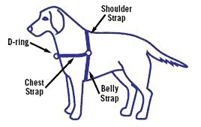Types of Collars
 Buckle Collars: These are pretty much what they sound like, collars that are fastened with a buckle. They are typically made of nylon, cotton, or leather, and are either flat or rolled. Buckle collars are adjustable, but do not tighten on the dog’s neck once fastened. Rolled leather collars avoid the chaffing or hair breakage that flat collars sometimes cause.
Buckle Collars: These are pretty much what they sound like, collars that are fastened with a buckle. They are typically made of nylon, cotton, or leather, and are either flat or rolled. Buckle collars are adjustable, but do not tighten on the dog’s neck once fastened. Rolled leather collars avoid the chaffing or hair breakage that flat collars sometimes cause.
 Quick-release Collars: These are basically flat nylon buckle collars, with a plastic closure that makes getting the collar on and off a little quicker (similar to some luggage strap fasteners). These collars are also adjustable, and also do not tighten once fastened.
Quick-release Collars: These are basically flat nylon buckle collars, with a plastic closure that makes getting the collar on and off a little quicker (similar to some luggage strap fasteners). These collars are also adjustable, and also do not tighten once fastened.
 No-slip Collars: These collars are a combination of slip collars and quick-release collars. They are adjustable collars designed to tighten around a dog’s neck, but to stop tightening before they actually constrict around the neck. They are good for dogs that tend to “slip” their collars. Some varieties are called “Martingale” or “Greyhound” collars.
No-slip Collars: These collars are a combination of slip collars and quick-release collars. They are adjustable collars designed to tighten around a dog’s neck, but to stop tightening before they actually constrict around the neck. They are good for dogs that tend to “slip” their collars. Some varieties are called “Martingale” or “Greyhound” collars.

Head Halters: Head halters (Gentle Leaders, Halti, Promise) are commonly used for dogs that pull. They are designed to mimic a halter used on horses. Head halters are not muzzles – the dog can still drink, eat, bark, and bite while wearing a head halter.
 Harnesses: Some people use harnesses in an attempt to stop their dogs from pulling when on lead. The best option for a harness is a FRONT CLASP HARNESS which allows the handler to control the dog from the front. Popular brands are Easy Walk, Halti or Freedom No-Pull. Even if the dog is still able to pull, the chest will be re-directed around, toward the handler.
Harnesses: Some people use harnesses in an attempt to stop their dogs from pulling when on lead. The best option for a harness is a FRONT CLASP HARNESS which allows the handler to control the dog from the front. Popular brands are Easy Walk, Halti or Freedom No-Pull. Even if the dog is still able to pull, the chest will be re-directed around, toward the handler.
What NOT to use:
- Retractable Leashes: While a retractable leash may give an owner a sense of allowing freedom for their pet, the reality is that loss of leash control and breakage are common, as well as injury, including leash burns and even digit amputation.
- Pinch/Prong Collars, Choke Chains: These are the common names of the metal training collars. Studies shows that choke chains cause a great deal of neck, back, and tracheal injuries to dogs. Their use has also been directly linked to thyroid damage in dogs.
While the prong collar is actually far safer than the choker when used correctly, studies evaluating its use found no neck/back/trachea injuries as a result of correct use of this collar – its use has been known to increase aggressive responses a dog may exhibit to other dogs, bikers, joggers, running children, etc. - Electronic (shock) collars (also used with electronic fencing) are strictly for training and should never be used without a professional’s guidance.
These types of collars work through force, pain and intimidation. If improperly used, these collars can cause serious injury and/or destroy a dog’s self-confidence, desire to work, and general good will.
